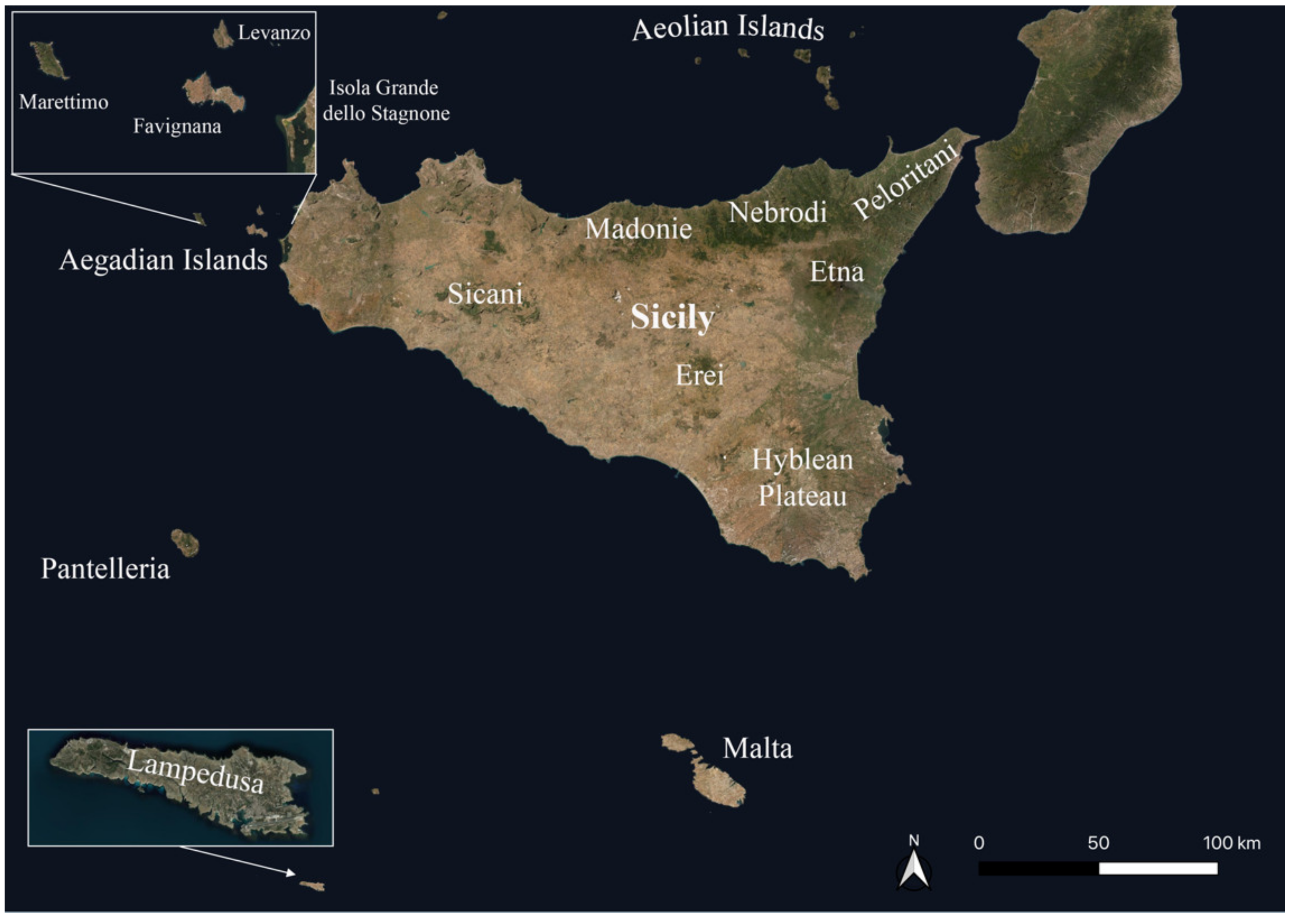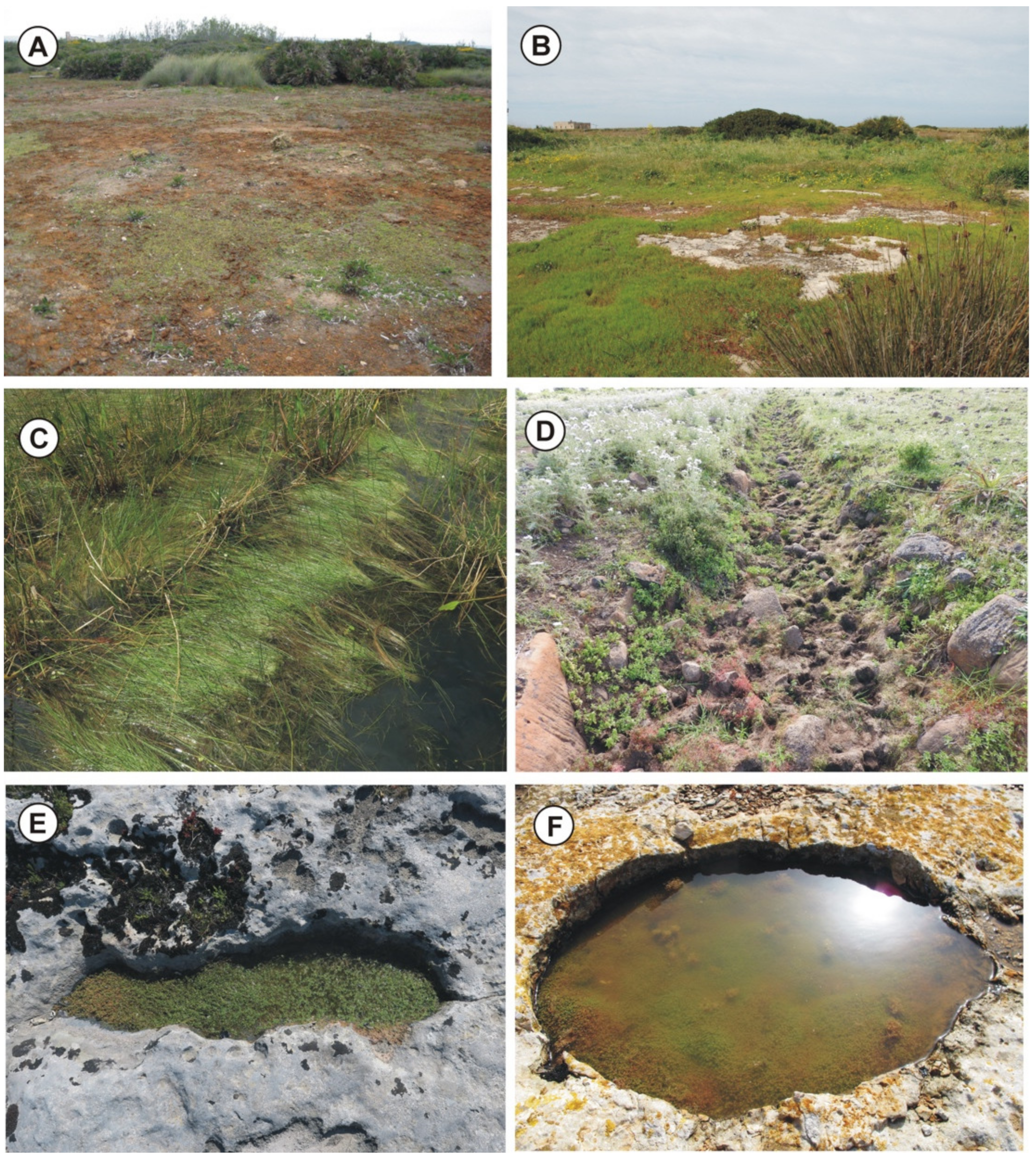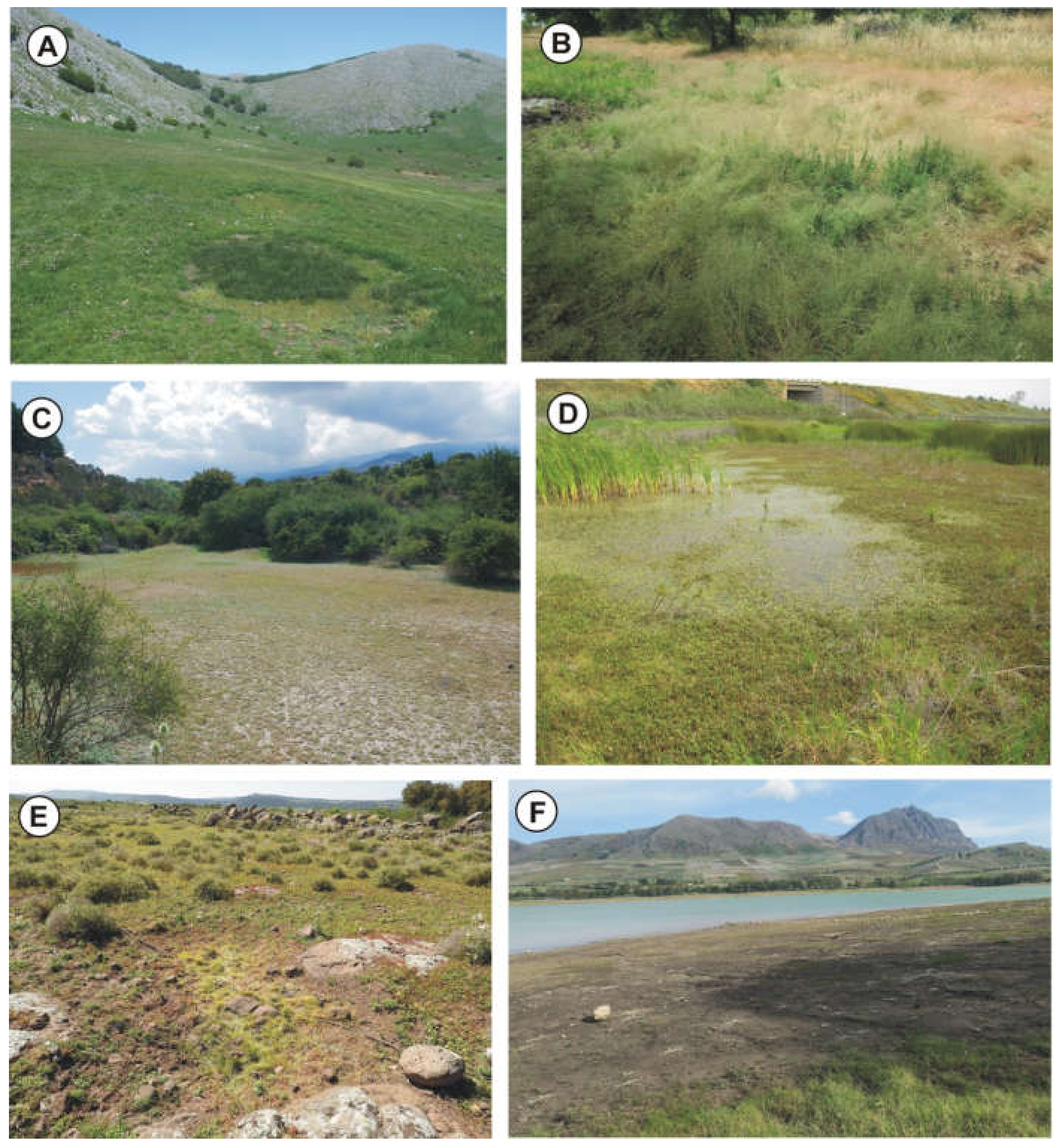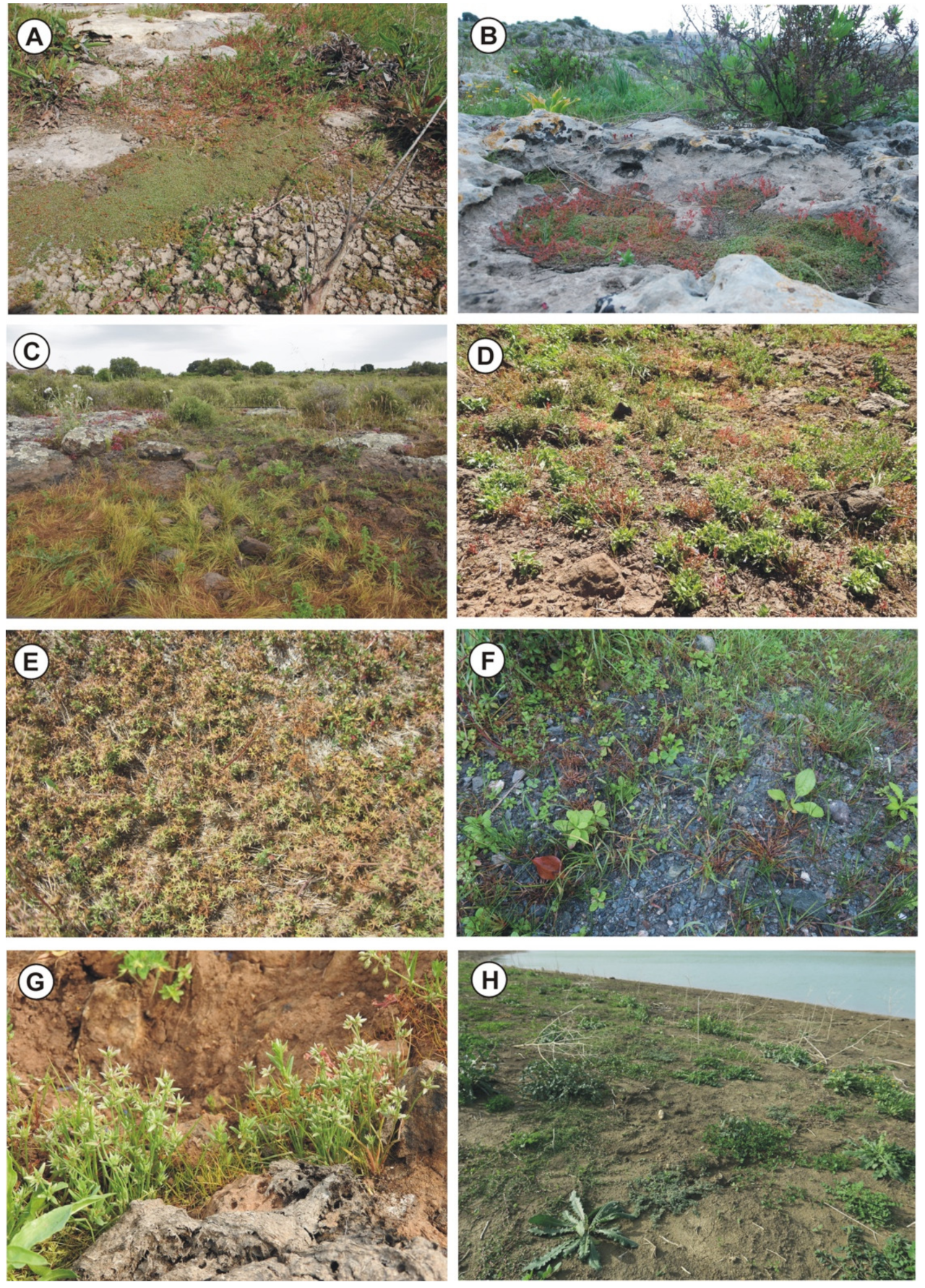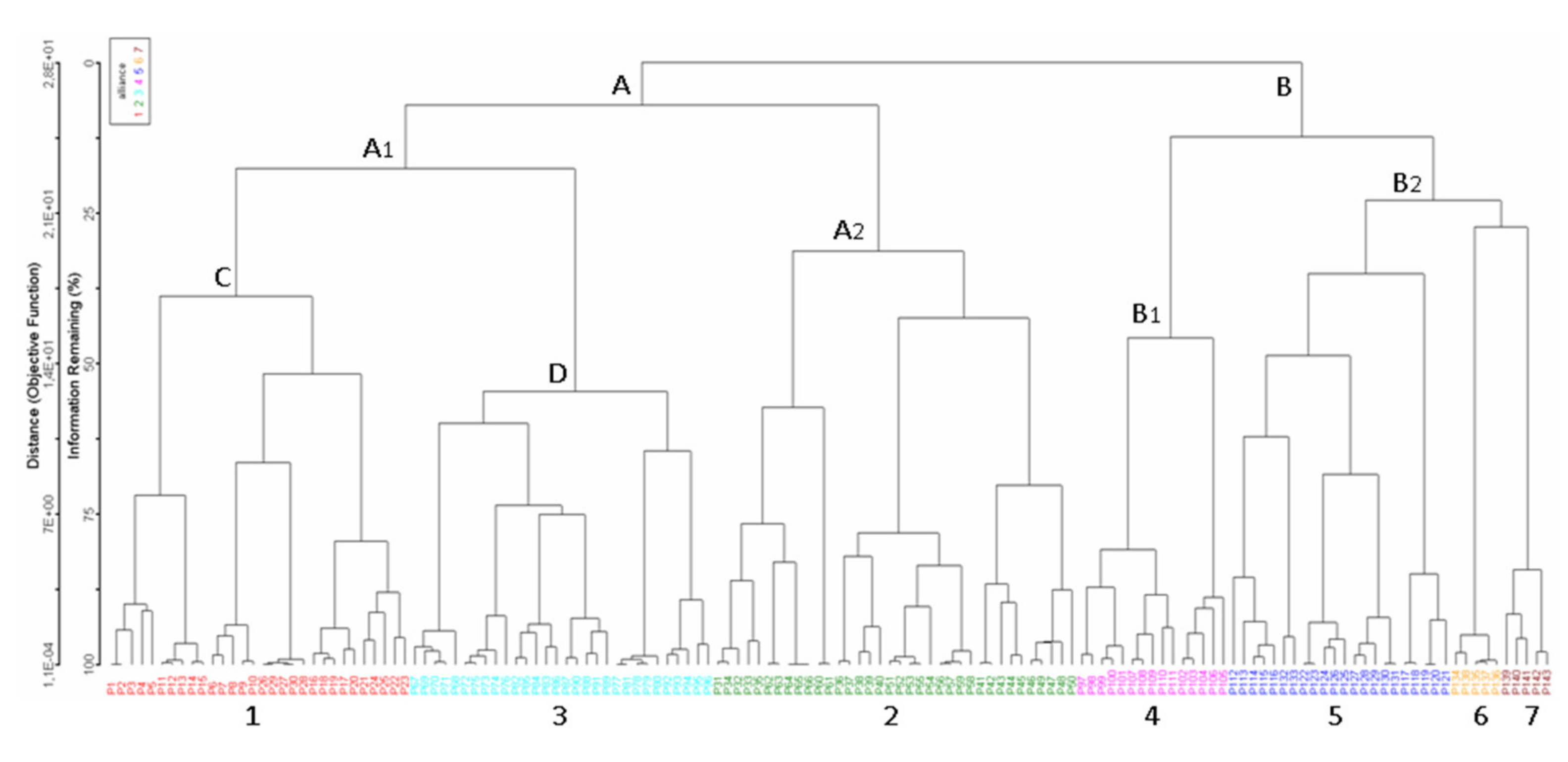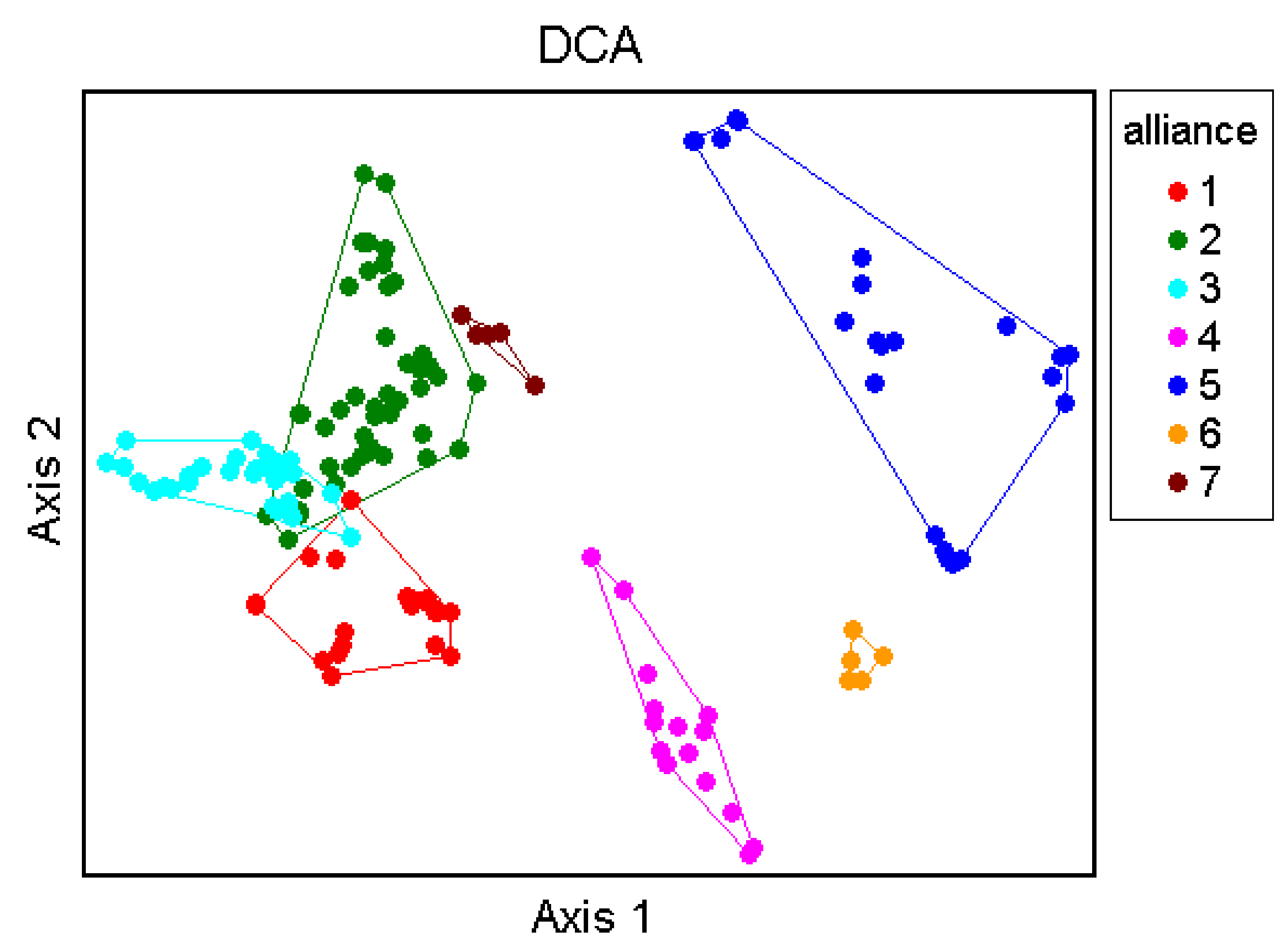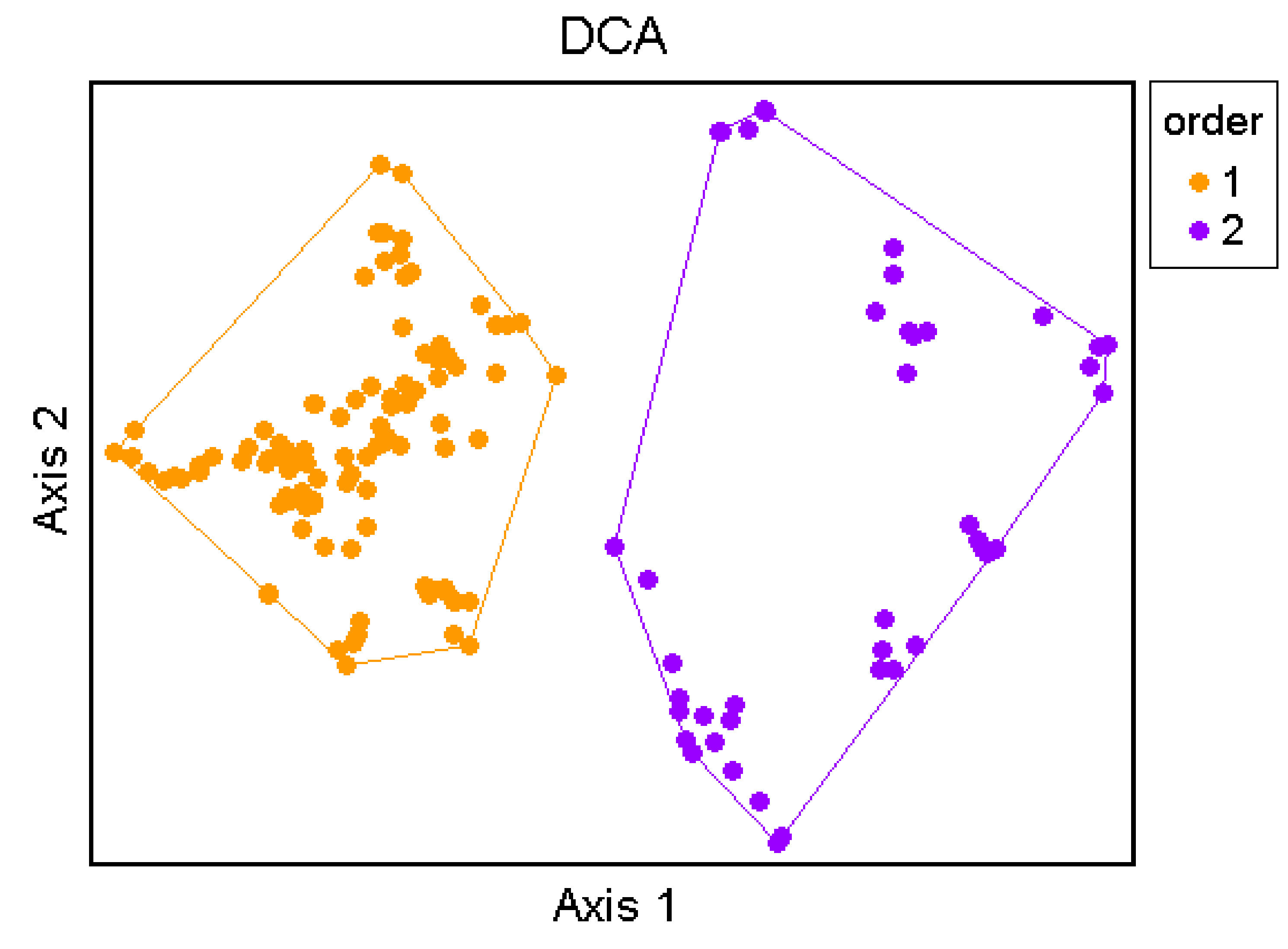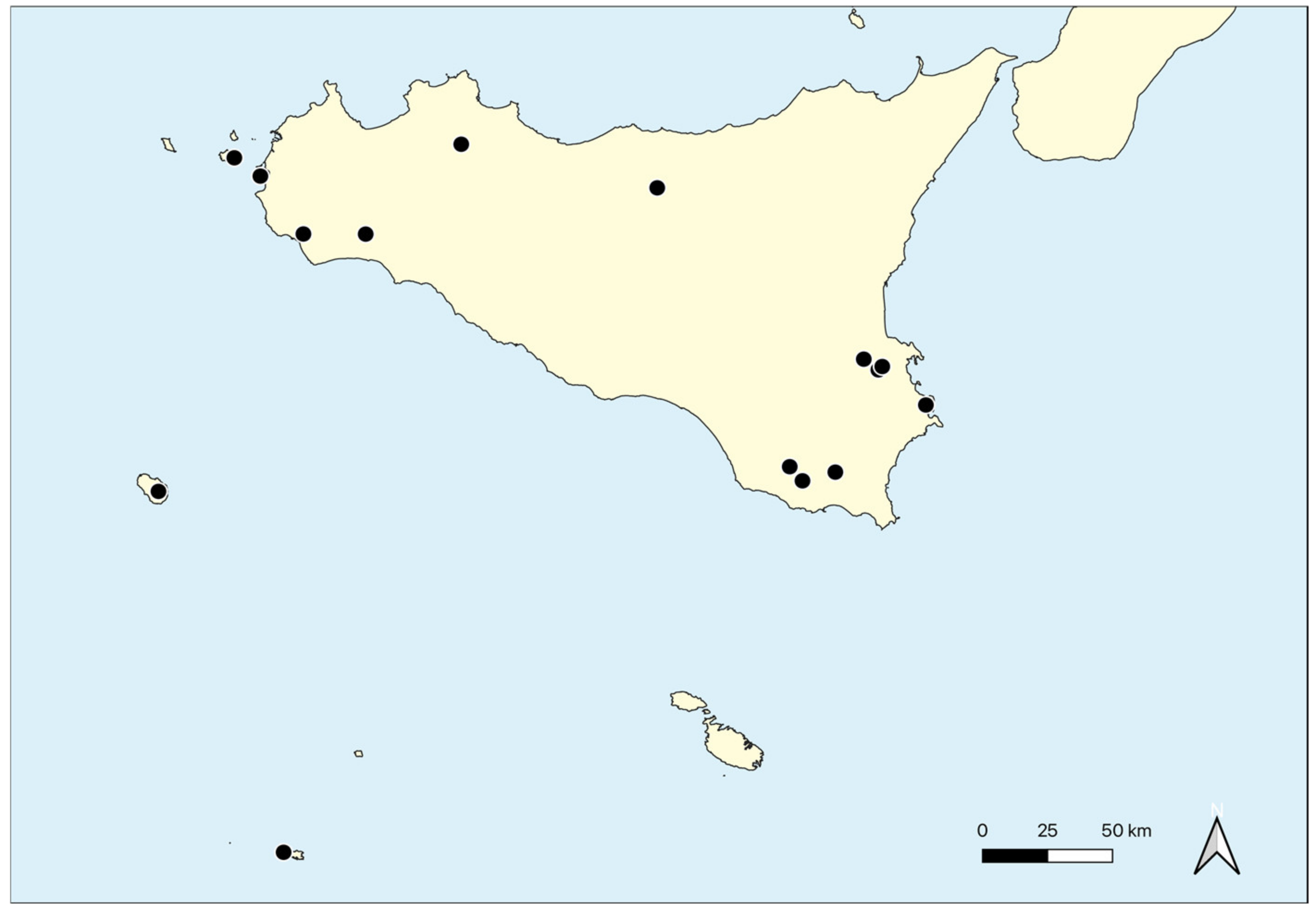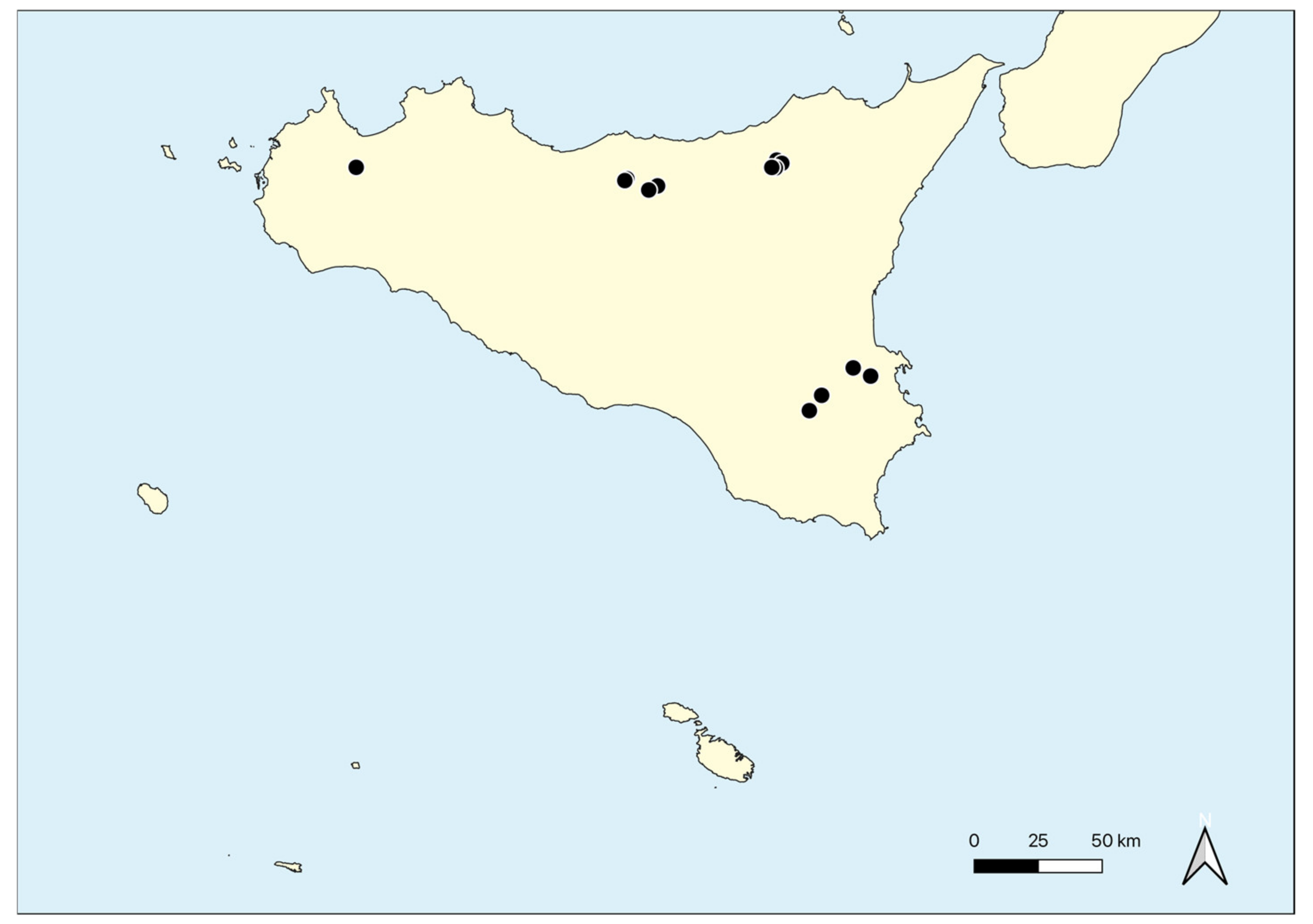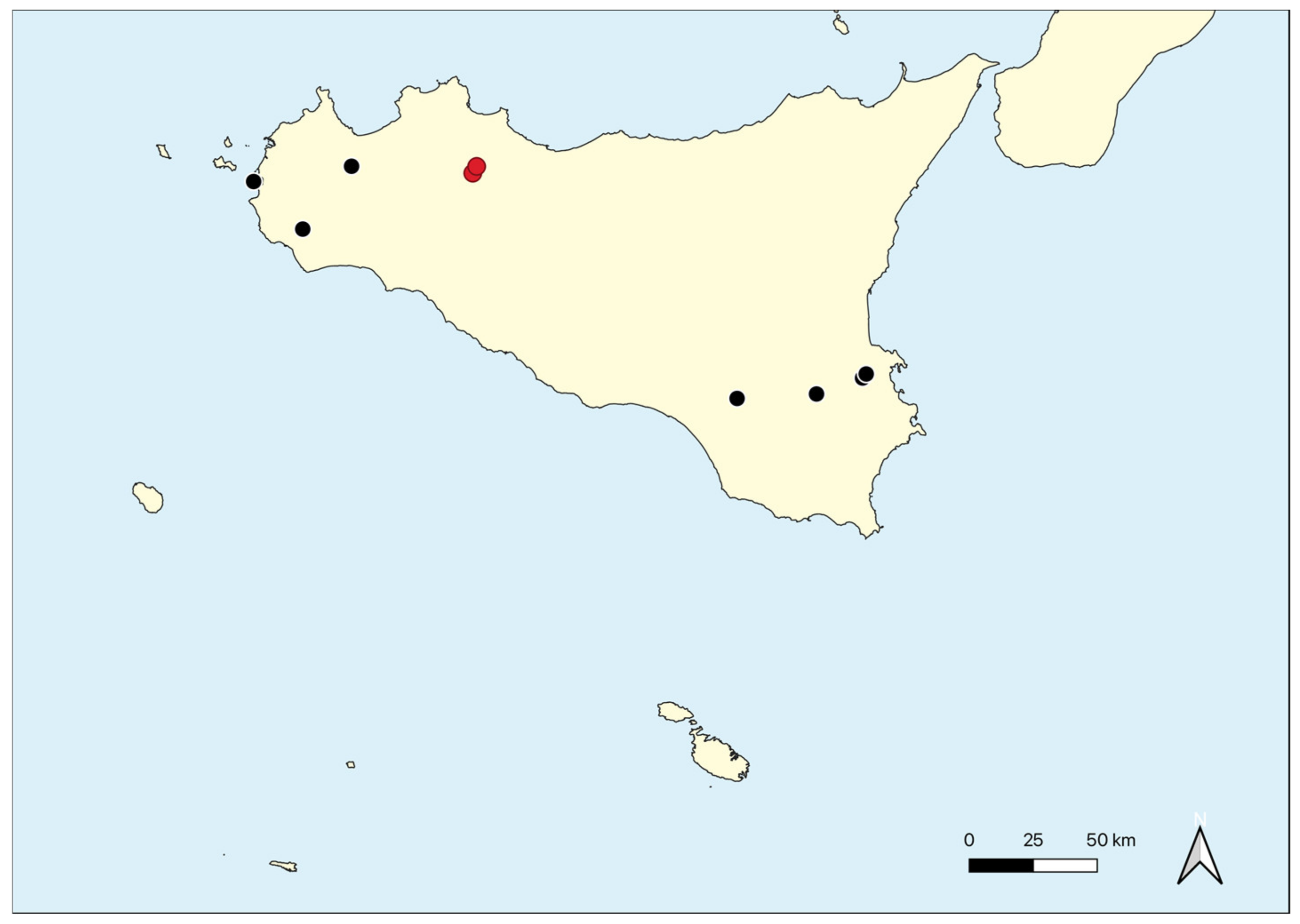2.3. Description of the Vegetation
ISOËTO-NANOJUNCETEA Br.-Bl. & R. Tx. ex Westhoff, Dijk & Passchier 1946, Overz. Plantegem. Neder. 2.:39.
Syn.: Isoëto-Nanojuncetea Br.-Bl. & R. Tx. 1943, Comm. S.I.G.M.A. 84: 7, nom. inval. (art. 2b, 8); Isoëto-Nanojuncetea Br.-Bl. & R. Tx. in Br.-Bl. et al. 1952, Group. Vég. Fr. Médit.: 80, nom. illeg. (art. 31); Isoëtetea velatae de Foucault 1988, Dissert. Bot. 121: 73; Juncetea bufonii de Foucault 1988, Dissert. Bot. 121: 78.
Lectotypus: Isoëtetalia Br.-Bl. 1936 nom. cons. propos.
Characteristic species: Damasonium bourgaei, Eryngium pusillum, Gaudinia fragilis, Juncus bufonius, J. capitatus, J. hybridus, J. pygmaeus, Lythrum hyssopifolia, Mentha pulegium, Myosurus minimus, Poa infirma, Polypogon subspathaceus, Pulicaria vulgaris var. vulgaris, Ranunculus sardous, Veronica anagalloides.
Structure and ecology: Ephemeral amphibious vegetation occurring in temporary wetlands with soils periodically flooded by oligotrophic, mesotrophic, eutrophic, or sometimes brackish waters [
39,
113,
114]. Floristically, these plant communities are dominated by hygrophilous therophytes often mixed with small hemicryptophytes and geophytes. These phytocoenoses correspond to a type of ephemeral vegetation, linked to very peculiar habitats characterized by a temporary submersion alternating with marked aridity, which in the absence of environmental alterations do not tend to evolve; therefore, they can be considered as communities representing ’permaseries’ of vegetation. The associations of this class usually fall in the habitat of Community interest 3170*, which is considered of priority importance [
115].
Geographical distribution: The associations of this class are widespread in Europe and all Mediterranean territories, including the Macaronesian islands.
ISOËTETALIA Br.-Bl. 1936, Bull. Soc. Et. Sci. Nat. Nimes, 47: 142 nom. cons. propos [
116].
Syn.: Isoëtetalia Br.-Bl. 1931, Comm. S.I.G.M.A. 9: 38, nom. nud. (art. 2b); Isoëtetalia velatae de Foucault 1988, Dissert. Bot. 121: 73.
Type:
Isoëtion Br.-Bl. 1936 conserved type proposed [
116]
Characteristic species: Archidium alternifolium, Briza minor, Bulliarda vaillantii, Catabrosa aquatica, Centaurium maritimum, Damasonium polyspermum, Elatine macropoda, Isoëtes longissima, I. sicula, Isolepis cernua, Lotus angustissimus, L. hispidus, L. parviflorus, Middendorfia borysthenica, Molineriella minuta, Myosotis sicula, Ranunculus muricatus, Romulea ramiflora, Trifolium micranthum, Triglochin laxiflora.
Structure and ecology: Pioneer ephemeral vegetation with thermophilous or subthermophilous requirements linked mainly to oligotrophic soils submerged up to early spring, sometimes flooded until early summer [
39,
113]. Usually, it is characterized by hygrophilous microphytes having an early spring blooming.
Geographical distribution: This order shows a Mediterranean and South Atlantic-European distribution.
Note: According to Fernández-González et al. [
116]
Isoëtetalia Br-Bl. 1936 is a superfluous name (Art. 29c), and homotypic of
Nanocyperetalia Klika 1935, having a nomenclature type
Nanocyperion flavescentis Koch 1926 (Art. 18b). The authors, to avoid publishing a new name for
Isoëtetalia, propose to use Art. 53 of the new ICPN [
117], which allows the preservation of its common use, proposing it as nomen conservandum having the
Isoëtion Br.-Bl. 1936 as conserved type.
Syn.: Isoëtion Br.-BI. 1931, Comm. S.I.G.M.A. 9: 38. nom. nud. (art. 2b); Antinorio agrostideae- Isoëtion velatae de Foucault 1988 Dissert. Bot. 121: 73, p.p.; Ophioglosso lusitanici- Isoëtion histricis de Foucault 1988, Dissert. Bot. 121: 74; Elatino-Damasonion alismae de FoucauIt 1988, Dissert. Bot. 121: 86, p.p.; Crassulo-Lythrion borysthenici de Foucault 1988, Dissert. Bot. 121: 90 p.p.;
Lectotypus: Isoëtetum duriei Br.-Bl. 1936
Characteristic species: Isoëtes durieui, I. histrix, Lotus conimbricensis, Ranunculus trilobus.
Structure and ecology: Pioneer and fleeting vegetation localized mainly in small ponds with shallow waters, rich in quillworts and microphytes, showing an early spring blooming, linked to warm Mediterranean climates. It colonizes small surfaces represented by rocky pools with very thin silty soils that dry up very early.
Geographical distribution: This alliance has a Mediterranean distribution and in Sicily, it occurs in the several localities of the Islands, as well as Pantelleria Island, Lampedusa Island, Favignana Island and Isola Grande dello Stagnone (
Figure 9).
- 1.
Isoëtetum durieui Br.-Bl. 1936, Bull. Soc. Étude Sci. Nat. Nîmes 47: 144 (
Appendix B,
Table A2)
Syn.: Ass. à Juncus capitatus - Isoëtes duriaei Br.-Bl. 1931, Comm. SIGMA 9 : 38 nom. nud. (art. 2b).
Lectotypus: rel. 3 Tab. «
Isoëtetum duriaei », Braun-Blanquet [
5]
Characteristic species: Isoëtes durieui, Juncus capitatus, Trifolium micranthum.
Structure and ecology: This association was described in southern France by Braun-Blanquet [
5] on siliceous substrata where it is localized on small rocky hollows submerged in the winter season. Floristically it is characterized by the dominance of
Juncus capitatus and
Isoëtes durieui, which grow together with other hygrophilous microphytes. In Sicily, the association occurs in the slightly depressed soils rich in silt and clay on siliceous substrata, where it is characterized by a very poor floristic set.
Geographical distribution: Previously, the
Isoëtetum durieui was recorded from southern France [
5,
8,
15], Catalonia in Spain [
118,
119,
120,
121,
122] and Corse [
123]. In Sicily, the plant communities referable to this association are very rare. In particular,
Isoëtetum durieui was quoted by Marcenò & Trapani [
85] from Piana degli Albanesi (Palermo); it occurs also in the Hyblean plateau near Carlentini.
- 2.
Pulicario graecae-Scirpetum savii Brullo & Di Martino 1974, Boll. Ist. Bot. Giard. Coll. Palermo 26: 49 (
Appendix B,
Table A3)
Lectotypus: rel. 10, Tab. 17, Brullo and Di Martino [
78], hoc loco.
Characteristic species: Isolepis cernua (= Scirpus savii), Pulicaria vulgaris var. graeca, Damasonium polyspermum, Damasonium bourgaei (sub D. stellatum).
Structure and ecology: The association was surveyed in the rocky ponds of the arenaceous outcrops submerged by rainwater during the winter. At the bottom of these small depressions, a thin layer of silt is deposited, where peculiar amphibious hygrophilous vegetation grows. In this habitat, the occurrence of some hygrophytes, such as
Isolepis cernua,
Pulicaria vulgaris var.
graeca,
Damasonium polyspermum,
Damasonium bourgaei is quite significant. These species, proposed as characteristic, are usually mixed with several other hygrophytes of
Isoëto-Nanojuncetea. The association colonizes small surfaces within the perennial vegetation belonging to
Sarcocornio fruticosae-Limonietum ferulacei juncetosum subulati, a hyper-halophilous association of
Salicornietea fruticosae [
78].
Geographical distribution: Currently, it is known only in the Isola Grande dello Stagnone (Trapani).
- 3.
Isoëto durieui-Ranunculetum parviflori Brullo, Di Martino & Marcenò 1977, Veg. Pantelleria: 82 (
Appendix B,
Table A4)
Holotypus: rel. 8. Tab. 12, Brullo et al. [
81].
Characteristic species: Isoëtes durieui, Ranunculus parviflorus.
Structure and ecology: The small, periodically flooded hollows on basaltic rocks, localized at about 600 m a.s.l., are colonized by hygrophilous vegetation dominated by
Isoëtes durieui and
Ranunculus parviflorus, which were proposed as characteristic species of a peculiar association named
Isoëto-Ranunculetum parviflori [
81]. In this vegetation, several species of
Isoëto-Nanojuncetea are frequent, such as
Ranunculus trilobus,
R. muricatus,
Juncus bufonius,
Lythrum hyssopifolia,
Lotus angustissimus,
Mentha pulegium, etc. Besides, two sub-associations can be identified within it:
isoëtetosum durieui corresponding to the typical aspect and
callitrichetosum brutiae, linked to conditions of greater edaphic humidity occurring in the central part of the depressions.
Geographical distribution: It is a very rare association exclusive of Pantelleria Island, where it is localized at Monte Gibele on the bottom of a volcanic crater.
- 4.
Crassulo vaillantii-Elatinetum gussonei Bartolo, Brullo, Minissale & Spampinato 1990, Boll. Acc. Gioenia Sci. Nat. Catania 21 (334): 205 (
Appendix B,
Table A5)
Holotypus: rel 6, Tab. 25 Bartolo et al. [
88].
Characteristic species: Elatine gussonei.
Structure and ecology: The association occurs in the rocky ponds circumscribed to the carbonatic outcrops submerged by freshwater during the autumn-winter period. These peculiar habitats are characterized by a thin layer of soil covered by 5–10 cm of water at the time of maximum flooding. Floristically, this vegetation is differentiated by the dominance of
Elatine gussonei, endemic to Lampedusa and Maltese islands [
124,
125], which is related to
Elatine macropoda. It usually grows together with
Buillardia vaillantii and other hygrophytes of
Isoëto-Nanojuncetea. As concerns its bioclimatic requirements, this plant community grows within the upper Infra-Mediterranean belt, with lower semiarid hombrotype [
96]. The climatophilous vegetation where it falls is represented by the thermo-xeric maquis belonging to the
Periplocion angustifoliae Rivas-Martinez 1975 [
88].
Geographical distribution: According to Bartolo et al. [
88] and Brullo et al. [
126], the
Crassulo vaillantii-Elatinetum gussonei is distributed in Lampedusa (Pelagie Islands) and Maltese Islands (
Figure 2F).
- 5.
Lythro hyssopifoliae-Elatinetum macropodae Brullo, Sciandrello, Tavilla & Minissale ass. nova hoc loco (
Appendix B,
Table A6)
Holotypus: rel 10, hoc loco.
Characteristic species: Elatine macropoda.
Structure and ecology: This vegetation grows in small and not very deep wet hollows, represented by cupular pools, occurring in limestone plateaus, which start to dry up at the beginning of spring. The relevant occurrence in this phytocoenosis of Elatine macropoda, species widespread in the Mediterranean territories, often shows high coverage values. The set of Isoëto-Nanojuncetea microphytes is well represented, such as Juncus bufonius, Buillardia vaillanti, Lythrum hissopifolia, Mentha pulegium, Poa infirma, etc. This community, due to the dominance of Elatine macropoda, shows some relationship with associations described for other Mediterranean territories, for instance, Elatinetum macropodae Br.-Bl. 1936 from south France and Junco pygmaei-Elatinetum macropodae Silva et al., 2021 from the Iberian Peninsula. However, the vegetation is floristically and ecologically well differentiated from these two associations. In particular, Elatinetum macropodae colonizes the basaltic rocky pools and is characterized, apart from Elatine macropoda, by Damasonium polyspermum, Herniaria glabra, Pulicaria vulgaris and Lythrum tribracteatum, which are species fully absent in the Sicilian community, while Junco pygmaei-Elatinetum macropodae is localized along the edge of streams or temporary ponds with muddy-sandy substrates and is differentiated by the occurrences of Juncus pygmaeus and Middendorfia borysthenica growing together with Elatine macropoda. As a whole, both these associations show marked differences in comparison with the vegetation surveyed in Sicily. In fact, the latter is floristically differentiated by the occurrence of Buillardia vaillantii, showing high cover values, which is lacking in the other two aforesaid associations. Therefore, this Sicilian plant community is here proposed as a new association, named Lythro hyssopifoliae-Elatinetum macropodae. It should be noted that this new association is quite similar to Crassulo vaillantii-Elatinetum gussonei from Lampedusa, mainly for the habitat where it grows and also for the occurrence of Buillardia vaillantii, while Elatine macropoda is replaced by Elatine gussonei. Within this association three subassociations can be distinguished, namely: (a) subass. typicum (rel. 10–20) differentiated by the dominance of Elatine macropoda, linked to cupular pools flooded by shallow waters; (b) subass. buillardietosum vaillantii subass. nov. (rel. 1–9, holotypus rel. 8, hoc loco) localized in the stands with quite deep waters; (c) subass. callitrichetosum brutiae subass. nov. (rel. 21–25, holotypus rel. 24, hoc loco) occurring exclusively on stands with very deep waters.
Geographical distribution: This association to the best of current knowledge is exclusive of the Hyblean basaltic plateau in southern Sicily (
Figure 2E and
Figure 4B).
- 6.
Buillardio vaillantii-Elatinetum campylospermae Brullo, Sciandrello, Minissale, Cambria, Ilardi & Giusso ass. nov., hoc loco (
Appendix B,
Table A7)
Syn.: Elatinetum macropodae Pasta et al. 2008, Nat. Sicil. ser. 4, 32 (1–2): 41, non Br.-Bl. 1936, Bull. Soc. Et. Sci. Nat. Nimes 47:154.
Holotypus: rel 14, hoc loco.
Characteristic species: Elatine campylosperma.
Structure and ecology: The small pools between limestone outcrops, both of natural and anthropogenic origin, usually named rocky pools, flooded in the autumn-winter period, and host highly specialized amphibious plant communities. In these stands,
Bulliarda vaillantii seems to have here its optimum, growing together with various other ephemeral hygrophytes, such as
Lythrum hyssopifolia,
Juncus bufonius,
Poa infirma,
Juncus capitatus,
Juncus hybridus,
Polypogon subspathaceus, etc. The occurrence of a very peculiar species of
Elatine, was quite significant; according to current knowledge of this genus, it can be attributed to
E. campylosperma, a Mediterranean species with a very scattered distribution [
127]. From the phytosociological point of view, this vegetation shows a close relationship with other Sicilian associations dominated by
Elatine sp. and
Bulliarda vaillantii, such as
Lythro hyssopifoliae-Elatinetum macropodae and
Crassulo vaillantii-Elatinetum gussonei, occurring in quite similar habitat, but differing among them from the floristic point of view, since characterized by other species of
Elatine. Therefore, the plant community at issue is proposed as a new association named
Buillardio vaillantii-Elatinetum campylospermae. Previously, this vegetation was wrongly attributed by Pasta et al. [
128] to
Elatinetum macropodae Br. Bl. 1936.
Geographical distribution: The association is localized in the North-western Sicily, where it occurs in some localities of the Trapani territory, such as Castello della Pietra (Castelvetrano), Isola Lunga dello Stagnone (Marsala) and Favignana island (Aegadian islands) (
Figure 2B,
Figure 4A and
Figure 5E).
- 7.
Holotypus: rel. 1, hoc loco.
Characteristic species: Isoëtes todaroana.
Structure and ecology: A rather rare and very peculiar community has been surveyed in small hollows on calcarenitic outcrops, submerged especially during the winter period. In this habitat
Isoëtes todaroana, a peculiar species described by Troia & Raimondo [
129], is localized. It grows on a thin layer of clay soil together with other hygrophytes of the
Isoëto-Nanojuncetea including, in particular:
Triglochin laxiflora,
Romulea ramiflora,
Isolepis cernua,
Mentha pulegium,
Lythrum hyssopifolia,
Juncus bufonius. The temporary wetland where this vegetation currently occurs is a remaining fragment of a larger marsh that has been reclaimed in a cultivated area, and therefore, it takes on a relict meaning. Hence, this phytocoenosis for its floristic and ecological features is proposed as a new association named
Isoëtetum todaroanae.
Geographical distribution: Currently, this association seems to have a punctiform distribution localizing in a small area near Mazara del Vallo (Trapani).
Syn.: Preslion Br.-Bl. 1931, Comm. S.I.G.M.A.: 38, nom. nud. (art. 2b); Menthion cervinae Br.-Bl. ex Moor 1936, nom. mut. propos. by Rivas-Martínez et al. (2002); Elatino-Damasonion alismae de FoucauIt 1988, Dissert. Bot. 121: 86, p.p.
Holotypus: Preslietum cervinae Br.-Bl. ex Moor 1937.
Characteristic species: Antinoria insularis, Callitriche brutia, Juncus foliosus, Pilularia minuta, Ranunculus lateriflorus, R. ophioglossifolius, R. pratensis, R. saniculifolius, Veronica serpyllifolia.
Structure and ecology: Thermophilous plant communities localized in cupular pools, temporary marshes and dolines with deep stagnant waters or in stands with deep-water runoff flooded for most of the spring. This vegetation is rich in creeping amphibian species mixed with hygrophilous microphytes.
Geographical distribution: This alliance shows a Mediterranean range and in Sicily, it occurs in some localities of the northern and southern parts of the Island (
Figure 10).
- 8.
Isoëto velatae-Crassuletum vaillantii Poiron & Barbero 1965, Bull. Soc. Bot. Fr., 112: 437 (
Appendix B,
Table A9)
Syn.: Association à Isoëtes velata et Crassula vaillantii Poiron & Barbero 1965, Bull. Soc. Bot. Fr. 112: 437
Lectotypus: rel. 9, Tab. pag. 439, Poiron & Barbero [
130], hoc loco.
Characteristic species: Crassula vaillantii, Isoëtes velata, Warnstorfia fluitans (= Drepanocladus fluitans).
Structure and ecology: The small rocky pools occurring on the basaltic plateau submerged in the rainy periods with very shallow waters persisting until the early spring, host a hygrophylous vegetation characterized by the dominance of
Isoëtes velata and
Crassula vaillantii, to which
Warnstorfia fluitans, a rare moss recently recorded from Sicily [
131], is often associated. It is a silicicolous community localized at 230–360 m a.s.l., that, according to Minissale et al. [
132], can be referred to as
Isoëto velatae-Crassuletum vaillantii, an association described in southern France by Poiron & Barbero [
130]. The Sicilian vegetation shows a floristic set and ecological requirements quite similar to the one surveyed in France. Apart from the subass.
typicum (rel. 1–12), in Sicily, is possible to distinguish a subass.
ranunculetosum ophioglossifolii Brullo, Minissale, Sciandrello & Tavilla subass. nov. (rel. 13–16, holotypus rel. 13, hoc loco) occurring in the stands with a longer flooding period, floristically differentiated by
Ranunculus ophioglossifolius and
Warnstorfia fluitans.
Geographical distribution: According to literature data, this association considered circumscribed to France and Italy [
51,
77,
130], occurs also in the Hyblean Plateau (southern Sicily), as already mentioned by Minissale et al. [
132].
- 9.
Ranunculo lateriflori-Antinorietum insularis Brullo, Grillo & Terrasi 1976, Boll. Acc. Gioenia Sci. Nat. Catania, 12: 92 (
Appendix B,
Table A10).
Lectotypus: rel. 11, Tab. 3, Brullo et al. [
80], hoc loco.
Characteristic species: Bulliarda vaillantii, Isoëtes sicula, Myosotis tineoi.
Structure and ecology: In the small wetlands and rocky pools occurring on the basaltic plateau at about 900 m of altitude, peculiar vegetation linked to habitats flooded until the early summer, when deep freshwater occurs. It is characterized by
Antinoria insularis and
Ranunculus lateriflorus, usually growing with
Buillardia vaillantii,
Isoëtes sicula and
Myosotis tineoi. This community was described by Brullo et al. [
80] as
Ranunculo lateriflori-Antinorietum insularis and attributed, even if doubtfully, to
Isoëtion. Effectively, due to the high frequency of
Antinoria insularis,
Ranunculus lateriflorus and
Callitriche brutia this association is to be included within
Preslion cervinae. Regarding its bioclimatic requirements, the association falls within the meso-Mediterranean subhumid belt. At first, two subassociations were recognized in this plant community, named
isoëtetosum and
ranunculetosum, differentiated, respectively, by
Isoëtes sicula, formerly identified as
I. durieui, linked to stands subject to a shorter submersion period, while the other one is dominated by
Callitriche brutia, localizing on longer flooded surfaces. According to Brullo & Minissale [
39], they must be considered as two distinct associations. The first one coincides with the association at issue, while the second one was named by Brullo & Minissale [
39]
Ranunculo lateriflori-Callitrichetum brutiae, which will be treated later.
Geographical distribution: This association occurs exclusively on the top of Monte Lauro in the Hyblean Plateau.
- 10.
Myosuro minimi-Ranunculetum lateriflori Raimondo 1980, Quaderni C.N.R., AQ/1/89: 15 (
Appendix B,
Table A11).
Holotypus: rel. 1, Tab. 2, Raimondo [
86].
Characteristic species: Myosurus minimus, Spergularia madoniaca, Sagina subulata, Ranunculus marginatus
Structure and ecology: The association is localized in mountain stands, at altitudes between 1400 and 1600 m a.s.l., especially on the bottom of large dolines, limitedly to the small depressions where water, resulting from the melting of snow, is stagnant for a long time. The soil is represented by clayey-silty deposits, resulting from the erosion of the surrounding carbonatic rocks, with an acidic pH, usually drying up towards the end of spring. These wet surfaces are colonized by dense vegetation with hygrophilous microphytes, where some of them play a relevant physiognomic role. In particular,
Myosurus minimus,
Spergularia madoniaca,
Antinoria insularis,
Ranunculus lateriflorus, are the most frequent, which are associated with several other hygrophytes of the
Isoëto-Nanojuncetea. The association, described by Raimondo [
86] as
Myosuro minimi-Ranunculetum lateriflori, was included in the
Isoëtion, while Brullo & Minissale [
39] put it in synonymy with
Ranunculo lateriflori-Antinorietum insularis. Based on the current knowledge this vegetation is more advisable to be kept as an autonomous association, closely related to the latter. As previously emphasized by Brullo et al. [
84], both for their localization in the mountain belt and for the floristic set, mainly due to the occurrence of
Ranunculus lateriflorus,
Myosuro-Ranunculetum lateriflori and also
Ranunculo-Antinorietum insularis can be considered as geographical vicariants of other allied associations, such as
Sedo nevadensis-Juncetum pygmaeis Quezel 1957 from Atlas range (North Africa),
Junco-Isoëtetum velatae Rivas Goday 1955 from Spain, and
Veronico-Ranunculetum lateriflori Quezel 1973 from Tauro massif (Turkey).
Geographical distribution: The association is localized in the Madonie massif (North Sicily) (
Figure 3A).
- 11.
Ranunculetum pratensi-lateriflori Brullo, C. Brullo & Giusso ass. nova hoc loco (
Appendix B,
Table A12).
Syn.: Ranunculo-Antinorietum insularis veronicetosum Brullo & Grillo 1978, Not. Soc. Ital. Fitosociol. 13: 45.
Holotypus: rel. 5, Tab. 7, Brullo & Grillo [
84], hoc loco.
Characteristic species: Ranunculus pratensis, Barbarea bracteosa, Veronica serpyllifolia.
Structure and ecology: In the mountain range of northern Sicily, at altitudes between 1300 and 1700 m a.s.l., in correspondence with wetlands periodically flooded by shallow waters; ephemeral hygrophilous vegetation with a typical spring cycle. The substrates consist of siliceous rocks, mainly represented by flysch and schists, covered by silty-clayey deposits. The vegetation colonizing these places is characterized by quite specialized hygrophytes, where a relevant physiognomic role is played by
Antinoria insularis and
Ranunculus lateriflorus, as well as by
R. pratensis,
Veronica serpyllifolia,
Barbarea bracteosa, which allow differentiating a new association, closely related to the
Ranunculo-Antinorietum insularis. Previously Brullo & Grillo [
84], treated this plant community as a subass.
veronicetosum of the last association. Nevertheless, apart from the different floristic sets, it is well diversified also from the ecological point of view, since it is distributed at higher altitudes, well over 1000 m a.s.l., and on different substrates. Therefore, it is proposed as
Ranunculetum pratensi-lateriflori, which is spread mainly in the supra-Mediterranean humid belt.
Geographical distribution: The association is recorded from the Nebrodi chain (northern Sicily).
- 12.
Ranunculo lateriflori-Callitrichetum brutiae Brullo & Minissale 1998, Itinera Geobot. 11: 281 (
Appendix B,
Table A13).
Syn.: Ranunculo-antinorietum insularis subass. ranunculetosum Brullo, Grillo & Terrasi 1976, Boll. Acc. Gioenia Sci. Nat. Catania, 12: 93.
Holotypus: rel. 21, Tab. 3, Brullo et al. [
80]
Characteristic species: Callitriche brutia.
Structure and ecology: This vegetation occurs in the pools with more or less deep waters, limited to the basaltic substrates covered by a thin clayey-loamy soil layer. From a floristic point of view, this vegetation is characterized by the dominance of
Callitriche brutia,
Ranunculus lateriflorus and
Bulliarda vaillantii. This association, described by Brullo & Minissale [
39], was treated by Brullo et al. [
80] as subass.
ranunculetosum of the
Ranunculo-Antinorietum insularis, and by Brullo et al. [
83] as subass.
ranunculetosum lateriflori of the
Callitricho-Crassuletum vaillantii; in either case, it represents a more hygrophilous variant of these associations.
Geographical distribution: The association is currently recorded only from Monte Lauro (Hyblean plateau).
- 13.
Callitricho brutiae-Crassuletum vaillantii Brullo, Scelsi, Siracusa & Tomaselli 1998, Boll. Acc. Gioenia Sci. Nat. Catania 29: 172 (
Appendix B,
Table A14).
Holotypus: rel. 1, Tab. 2, Brullo et al. [
83].
Characteristic species: Callitriche brutia.
Structure and ecology: In the deeper depressions of the basaltic substrata, often submerged until the end of springtime, Anagallido parviflorae-Molinerielletum minutae is replaced by Callitricho brutiae-Crassuletum vaillantii, an association with more hygrophilous requirements. Floristically, this vegetation is characterized by the dominance of Callitriche brutia and Bulliarda vaillantii, which grows together with other hygrophilous species of the Isoëto-Nanojuncetea. It shows some relations with Ranunculo lateriflori-Callitrichetum brutiae, from which it differs in lower hygrophily and absence of Ranunculus lateriflorus, while Coleostephus myconis occurs, which emphasizes the more xericity of the stands.
Geographical distribution: The association is currently recorded only from Bosco Pisano (Hyblean plateau).
- 14.
Junco pygmaei-Pilularietum minutae Minissale, Molina & Sciandrello 2017, Botany Letters 164: 200 (
Appendix B,
Table A15).
Holotypus: rel. 8, Tab. 1, Minissale et al. [
132])
Characteristic species: Pilularia minuta
Structure and ecology: This is a very rare association localized on basaltic substrata, where it grows on ponds and drainage ditches, mainly on flat or slightly sloping surfaces with a superficial clayey or clayey-silty soil layer. This vegetation is distributed at 360-400 m a.s.l., within the thermo-Mediterranean bioclimatic belt. Floristically, it is characterized by the occurrence of
Pilularia minuta, usually growing with some hygrophilous species of
Isoëto-Nanojuncetea, among them, such as
Juncus pygmaeus,
Isoëtes longissima,
Lotus angustissimus,
Lythrum hyssopifolia,
M. borysthenica,
Callitriche brutia,
Bulliarda vaillantii,
Mentha pulegium, etc. Within this association, two subassociation can be distinguished: the
typicum (rel. 10–14) localized in the natural ponds and differentiated by
Solenopsis laurentia subsp.
hyblaea and
Cicendia filiformis, while the
tillaetosum vaillantii Minissale, Molina & Sciandrello (rel. 1–9, holotypus rel. 4, hoc loco) grows in the drainage ditches and is characterized by the occurrence of
Buillardia vailantii [
132]. This association shows some relations with other plant communities rich in
Pilularia minuta described from other Mediterranean territories, which were quoted by Tomaselli et al. [
51] too. In particular, among them
Isoetetum setacei Br-Bl. 1936 from southern France and the Iberian Peninsula can be mentioned, along with
Pilulario minutae-Isoetetum longissimae Tomaselli et al. 2020 from Apulia,
Eryngio corniculati-Isoetetum velatae Paradis & Finidori 2005 from Sardinia. On the whole, all these associations are floristically and ecologically well differentiated from
Junco pygmaei-Pilularietum minutae.Geographical distribution: Based on the current knowledge, this association is exclusive of a small area of the Hyblean Plateau near Sortino and Carlentini (
Figure 2D,
Figure 4G and
Figure 5C).
- 15.
Pilulario minutae-Myosotidetum siculae Brullo, Cambria, Ilardi & Minissale ass. nova hoc loco (
Appendix B,
Table A16).
Holotypus: rel. 1, hoc loco
Characteristic species: Pilularia minuta and Myosotis sicula.
Structure and ecology: The association was surveyed in wide temporary wetlands flooded during the winter-spring period, localized on clayey-siliceous substrates covered by deep muddy soils. This vegetation is distributed about 200 m a.s.l., within the thermo-Mediterranean bioclimatic belt. It is characterized by the occurrence of
Pilularia minuta, a rare and inconspicuous fern, which was recently rediscovered in Sicily by Troia & Lansdown [
133]. This hygrophyte usually grows with other species of the
Isoëto-Nanojuncetea, such as
Myosotis sicula. Ranunculus ophioglossifolius,
Isoëtes longissima,
Lotus parviflorus,
Elatine macropoda, etc. For its ecology and floristic set, it is well differentiated from the
Junco pygmaei-Pilularietum minutae, as well as from the
Pilulario minutae-Isoetetum longissimae.
Geographical distribution: This association seems localized in Contrada Anguillara near Calatafimi (western Sicily).
Syn.: Cicendion auct. medit. non Br.-Bl. 1967, Vegetatio 14: 28.
Holotypus: Laurentio-Anthocerotetum dichotomi Br.-Bl. 1936, Bull. Soc. Et. Sci. Nat. Nimes 47: 9.
Characteristic species: Anagallis minima, A. parviflora, Cicendia filiformis, Kickxia cirrhosa, Ophioglossum lusitanicum, Radiola linoides, Solenopsis laurentia subsp. laurentia. S. gasparrinii, S. laurentia subsp. hyblaea.
Structure and ecology: This alliance groups spring communities with acidophilus requirements, markedly more sciaphilous and hygrophilous than those of the
Isoëtion, with soils remaining humid for long periods. They are localized on waterlogged soils of large hollows with waterproof surfaces, sometimes represented by a wood clearing, covered by a thick layer of clay-silt soil, usually rich in a sandy component. It can be observed also in rocky ponds with sandy soils. In these stands, the hygrophilous microphytes are submerged by shallow rainwater often until late spring. Mucina et al. [
114] synonymized this alliance with
Cicendion (Rivas Goday in Rivas Goday & Borja 1961) Br.-Bl. 1967, and included it within the
Isoëtetalia. When Rivas Goday & Borja (1961) described this syntaxon, they treated it as
Cicendenion (sub
Cicendion), considering it as a suballiance of
Nanocyperion flavescentis Koch 1926, including within it the
Cicendietum filiformis Allorge 1922, which represents, therefore, its nomenclature type. Later, Braun-Blanquet [
18] raised this syntaxon to the alliance level, including within it the new association
Isoëto velatae-Cicendietum filiformis. In particular, the
Cicendietum filiformis, described from northern France is characterized by a floristic set rich in elements of the
Nanocyperetalia order, such as
Isolepis setacea,
Juncus tenuis,
Cyperus flavescens,
C. fuscus,
Lythrum portula,
Spergularia rubra,
Sagina procumbens,
Centaurium pulchellum,
Gnaphalium ulginosum,
G. luteo-album, while the floristic elements of
Isoëtetalia are absent. Besides, it should be noted that from the nomenclatural viewpoint, the
Radiolion linoidis Pietsch 1973 represents a synonym of the
Cicendion as emphasized by Brullo & Minissale [
39]. In fact, the two syntaxa are floristically and ecologically perfectly overlapping, since either way the associations referred to them (
Cicendietum filiformis included) have the optimum at last spring to early summer, and occur in the territories with temperate bioclimate. Besides, both are characterized by a peculiar pool of species, such as
Centunculus minimus,
Radiola linoides,
Hypericum humifusum,
Montia minor,
Chaetonychia cymosa, and many other of the
Nanocyperetalia order.
Geographical distribution: The alliance is well represented in the western and central Mediterranean area and in Sicily, it occurs in some localities of the western and southern part of the Island (
Figure 11).
- 16.
Archidio phascoidis-Isoetetum velatae Brullo & Minissale 1998, Itinera Geobot. 11: 281 (
Appendix B,
Table A17).
Holotypus: rel. pg. 281 related to Archidio phascoidis-Isoetetum velatae Brullo & Minissale (1998).
Characteristic species: Archidium phascoides, Isoëtes longissima (= Isoëtes velata)
Structure and ecology: Hygrophilous vegetation that prefers small humid depressions, on basaltic substrata covered by a shallow silty soil layer, subject to flooding during the autumn-winter period. From a structural point of view, the vegetation is characterized by a low moss carpet dominated by Archidium phascoides, on which numerous hygrophilous microphytes grow, such as, Solenopsis laurentia subsp. hyblaea, Juncus bufonius, J. pygmaeus, J. capitatus, Anagallis parviflora, Centaurium maritimum, etc. The occurrence of some Isoëtes, such as I. longissima, I. durieui and I. histrix is significant. The association is quite rare localizing at 230–385 m a.s.l., within the thermo-Mediterranean sub-humid bioclimatic belt.
Geographical distribution: The association occurs on scattered volcanic rocks in the Hyblean Plateau (
Figure 3E and
Figure 4C,D).
- 17.
Anagallido parviflorae-Molinerielletum minutae Brullo, Scelsi, Siracusa & Tomaselli 1998, Boll. Acc. Gioenia Sci. Nat. Catania 29: 172 (
Appendix B,
Table A18).
Holotypus: rel. 4, Tab. 1, Brullo et al. [
83]
Characteristic species: Molineriella minuta
Structure and ecology: Hygrophilous vegetation linked to flat stands with shallow loamy soils deposited on basaltic substrates, subject to short periods of submersion during the autumn and winter months. It is an ephemeral association with a very early vegetative cycle (late winter-early spring), in which a remarkable floristic set occurs, represented mainly by microphytes of the
Isoëto-Nanojuncetea. Among them,
Isoëtes durieui,
Anagallis parviflora,
Lotus conimbricensis,
L. angustissimus,
Lythrum hyssopifolia,
Juncus bufonius,
J. capitatus,
J. pygmaeus,
Polypogon subspathaceus,
Mentha pulegium,
Poa infirma, etc., can be mentioned. Besides, particularly significant is the occurrence of
Molineriella minuta, a species very rare in Sicily, which is treated as a characteristic species of the association. Within this community, two sub-associations were identified:
typicum, which occupies poorly wet peripherical places subject to a very short period of submersion, and
crassuletosum vaillantii, differentiated by the dominance of
Buillardia vaillantii, which is localized in the central part of the depressions with deeper waters [
83].
Geographical distribution: This association is reported from Bosco Pisano near Buccheri (Hyblean plateau).
- 18.
Kickxio cirrhosae-Solenopsietum gasparrinii Brullo & Minissale 1998, Itinera Geobot. 11: 281, nom. corr. (
Appendix B,
Table A19).
Syn.: Kickxio cirrhosae-Solenopsietum laurentiae Brullo & Minissa1e 1998, Itinera Geobot. 11: 281; Laurentio-Juncetum tingitani Brullo, Scelsi & Siracusa 1994, Boll. Acc. Gioenia Sci. Nat. Catania 27:359, non Rivas Goday & Borja in Rivas Goday 1968, Collect. Bot. 7(2): 1022.
Holotypus: rel. 4, Tab. 11, Brullo et al. [
134]
Characteristic species: Kickxia cirrhosa.
Structure and ecology: It is a microphytic association growing on muddy-sandy soils, limited to small ponds localized within halophilous meadows belonging to the
Limonio dubii-Lygeetum sparti Brullo & Di Martino 1974. In this vegetation several elements of the
Cicendio-Solenopsion laurentiae occur, such as
Kickxia cirrhosa,
Solenopsis gasparrinii,
Cicendia filiformis,
Radiola linoides,
Ophioglossum lusitanicum,
Centunculus minimum, etc., which highlights its acidophilic and markedly hygrophilous requirement. It has its optimum in the spring period, especially in very rainy years. Previously, this vegetation was referred to by Brullo et al. [
134] as the
Laurentio-Juncetum tingitani association described in the Iberian Peninsula by Rivas Goday & Borja [
105] and later treated by Brullo & Minissale [
39] as a new association named
Kickxio cirrhosae-Solenopsietum laurentiae. Based on the current knowledge, the name of this association must be corrected in
Kickxio cirrhosae-Solenopsietum gasparrinii, since
Solenopsis laurentia is here replaced by
S. gasparrinii.Geographical distribution: This association currently is reported only from the Isola Grande dello Stagnone near Marsala.
- 19.
Solenopsietum mothianae Brullo, Giusso, Minissale & Sciandrello ass. nova hoc loco (
Appendix B,
Table A20).
Holotypus: rel. 3, hoc loco
Characteristic species: Solenopsis mothiana
Structure and ecology: This association was surveyed on wide wetlands with silty-sandy and slightly brackish soils in stands near the sea. Usually, this vegetation is localized in temporarily flooded surfaces occurring in the large clearings within the maquis and is floristically differentiated by
Solenopsis mothiana, a rare endemic microphyte described by Brullo et al. [
135]. It grows together with
Anagallis parviflora,
Radiola linoides,
Cicendia filiformis,
Centaurium maritimum,
Briza minor,
Mentha pulegium,
Juncus bufonius,
Lythrum hyssopifolia, etc. It is very peculiar vegetation floristically and is ecologically well differentiated from the other Sicilian association of the
Cicendio-Solenopsion laurentiae.
Geographical distribution: This association is exclusive of the Isola Grande dello Stagnone near Marsala, where it is very rare (2A).
- 20.
Solenopsio gasparrinii-Isoëtetum siculae Brullo, Cambria, Ilardi & Minissale ass. nova, hoc loco (
Appendix B,
Table A21).
Holotypus: rel. 2, hoc loco
Characteristic species: Isoëtes sicula
Structure and ecology: This association is localized in the wide wetlands that are temporarily flooded, especially in the autumn-winter time, and which tend to dry up since the early spring. It grows on silty-sandy soils which keep the humidity throughout the spring and is differentiated by several small hygrophytes showing a high value of coverage. Floristically, this vegetation is characterized by Isoëtes sicula, which grows with Solenopsis gasparrinii, Ophioglossum lusitanicum, Anagallis parviflora, Anagallis minima, Radiola linoides, Cicendia filiformis, Lotus parviflorus, Romulea ramiflora, Isolepis cernua, Juncus bufonius, etc. Currently, the Solenopsio gasparrinii-Isoëtetum siculae, similarly to most microphytic associations of the Isoëtetalia, has a very narrow distribution due to human pressure, in particular for the reclamation of wetlands and their use in farming land.
Geographical distribution: This association occurs in western Sicily near Calatafimi and Mazara del Vallo (Trapani) (
Figure 5A).
- 21.
Myosotido congestae-Isoëtetum histricis Azzaro & Cambria ass. nova, hoc loco (
Appendix B,
Table A22).
Holotypus: rel. 2, hoc loco.
Characteristic species: Isoëtes histrix, Myosotis congesta, Aphanes arvensis.
Structure and ecology: The wide wetlands characterized by sandy soils, which are flooded by rainwaters in the autumn-winter period, are colonized by peculiar hygrophilous vegetation dominated by
Isoëtes histrix. In this stand, remaining quite wet during the springtime, some rare microphytes, such as
Myosotis congesta and
Aphanes arvensis, occur too. In particular,
Myosotis congesta was recently quoted as a new record from Italy by Azzaro et al. [
136] and subsequently typified by Tavilla et al. [
137], which provides some information on its morphological, ecological and chorological features. This vegetation, for its floristic and ecological peculiarities, is proposed as a new association, named
Myosotido congestae-Isoëtetum histricis, which shows a quite poor floristic set and can be referred to as
Cicendio-Solenopsion laurentiae for its ecological requirements and the occurrence of
Anagallis parviflora. The association is localized within the clearings of thermophilous
Quercus suber woodlands.
Geographical distribution: This association is very rare and was observed only inside the nature reserve “Bosco di Santo Pietro” near Caltagirone (southern Sicily).
Syn.: Pre-Isoetion Rivas Goday 1955, Anal. Inst. Bot. Cavanil1es 8: 385 nom. inval. (art. 3b); Agrostion salmanticae Rivas Goday 1956, Anal. Insl. Bol. Cavanilles 8: 387, nom. nud. (art. 2b); Agrostion pourretii Rivas Goday 1958, nom. mutand. propos. by Rivas Martinez et al. (2002: 248).
Lectotypus: As. Pulicaria uliginosa et Agrostis salmantica Rivas Goday 1956, Anal. Inst. Bot. Cavanilles 8: 386.
Characteristic species: Agrostis pourretii, Chamaemelum fuscatum, Trifolium michelianum.
Structure and ecology: Spring blooming communities, which are linked to humid depressions with long-lasting waters in winter and spring and with predominantly arenaceous soils. Physiognomically, they are dominated by graminoid therophytes and show their optimum in the late spring.
Geographical distribution: The associations of this syntaxon are frequent in the Iberian-Atlantic and West Mediterranean area (Spain, France, Corse, Sardinia, Sicily, and southern Italy). In Sicily, it is localized in the North-West part of the Island (
Figure 11).
- 22.
Trifolio micheliani-Agrostidetum pourretii Cambria & Brullo ass. nova hoc loco (
Appendix B,
Table A23).
Syn.: Trifolio micheliani-Glycerietum spicati Caldarella, La Rosa, Cusimano, Romano & Gianguzzi 2013, Plant Biosyst. 147(4): 7, p.p.
Holotypus: rel. 3, hoc loco.
Characteristic species: Trifolium michelianum.
Structure and ecology: In the wide wetlands characterized by silty-sandy soils deposited on flyschoid clays, dense vegetation dominated by
Agrostis pourretii and
Trifolium michelianum occurs. In particular, the plant community characterized by these species colonizes small stands localized within clearings of deciduous oak woods, where it is mixed with perennial hygrophilous vegetation linked to surfaces submerged by deeper waters. Previously, Caldarella et al. [
138] described a very heterogeneous association including both the perennial vegetation of
Phragmito-Magnocaricetea and the annual phytocoenosis with
Agrostis pourretii belonging to
Isoëto-Nanojuncetea, which was proposed as
Trifolio micheliani-Glycerietum spicati. Indeed, this association represents very complex vegetation including two well distinct communities belonging to different phytosociological classes. In fact, these authors carried out their relevés on very large surfaces (70–100 m
2) without respecting the criterion of the floristic-ecological homogeneity of the surveyed vegetation. This is evident in the floristic set of the relevés, including species of various phytosociological typologies (
Phragmito-Magnocaricetea,
Molinio-Arrhenatheretea and
Isoëto-Nanojuncetea). In particular, within these wide wetlands, the plant communities belonging to
Isoëto-Nanojuncetea are localized on small surfaces (at most 10–20 m
2), with soils that are already emerged in early spring compared to the surrounding surfaces still inundated. In fact, the floristic set in these stands consists almost exclusively of hygrophilous therophytes belonging to the
Isoëto-Nanojuncetea class. This vegetation is, therefore, proposed as a new association named
Trifolio micheliani-Agrostidetum pourretii, which for its floristic and ecological peculiarities must be referred to as
Agrostion salmanticae. Previously, associations referring to this alliance were described in the Italian territory from North Sardinia by Biondi & Bagella [
75] and Bagella et al. [
77] and Apulia by Tomaselli et al. [
51], represented, respectively, by
Anthoxantho aristati-Agrostidetum salmanticae and
Phalarido minoris-Agrostidetum pourretii.Geographical distribution: This vegetation was surveyed near Ficuzza (North Sicily) (3B).
NANOCYPERETALIA Klika 1935, Beih. Bot. Cent.bl. 53: 292, nom. cons. propos. [
116]
Syn.: Nanocypero-Polygonetalia W. Kock 1926, Jb. St. Gall. Natunviss. Ges. 61:20, nom. rejic. propos.; Cyperetalia fusci Müller-Stoll & Pietsch in Lohmeyer et al. 1962, Melhoramento, 15:20; Cyperetalia fusci Pietsch 1963, Abh. u. Ber. Naturkundemus 38:3, nom. illeg. (art. 29); Cicendietalia filiformis Géhu 1992, Ann. Bot. (Roma) 50: 139, nom. nud. (2b); Elatino triandrae-Cyperetalia fusci de Foucault 1988, Dissert. Bot. 121: 78.
Holotypus: Nanocyperion flavescentis W. Koch 1926.
Characteristic species: Centaurium pulchellum, Corrigiola litoralis, Cyperus fuscus, C. michelianus, Hordeum marinum, Laphangium luteoalbum, Lythrum portula, Plantago intermedia, Spergularia rubra.
Structure and ecology: This syntaxon group’s ephemeral vegetation localized in wide wet hollows usually flooded until early summer, with soils being mostly eutrophic or sub-eutrophic, often hypertrophic, and usually well nitrified since they are used as pastures, or more rarely oligo-mesotrophic. Floristically, it is differentiated by the occurrence of species with summer-autumn blooming, showing a prostrate and creeping habit.
Geographical distribution: This order is distributed in the Atlantic and central European territories, extending also to the Mediterranean ones with Temperate bioclimate, such as mountain stands or in artificial basins and along the coastal places with slightly brackish soils.
Notes: According to Fernández-González et al. [
116], the correct name of the order at issue is
Nanocypero-Polygonetalia Koch 1926 for reasons of priority, as it was validly published (Art. 2b, ICPN). Indeed, Koch [
3] within this order included two new alliances, such as
Nanocyperion flavescentis and
Polygono-Chenopodion polyspermi, of which the second is invalid according to Art. 3f (ICPN), while the
Nanocyperion flavescentis is a valid alliance. Indeed, Koch [
3] did not provide relevés but unambiguously referred it to an association validly published by Braun-Blanquet [
139], namely
Junco compressus-Parvo-Cyperus-Association. Besides,
Cyperus flavescens L. occurs in the typical relevé, which, therefore, validates the
Cyperetum flavescentis proposed by Koch [
3]. Unfortunately, this name is a superfluous name for the
Junco compressi-Parvo-Cyperetum (Art. 29c, ICPN). In conclusion, Fernández-González et al. [
116], proposed that, as
Nanocypero-Polygonetalia is a disused name,
Nanocyperetalia Klika 1935 should be the nomen conservandum, since the latter has always been the name used in literature.
Syn.: Nanocyperion flavescentis W. Koch ex Libbert 1932, Verh. Bol. Ver. Prov. Brandenburg 74: 21; Junclon bufonii Phi1ippi 1968, Vertiff. Land. Natur. Landsch. Bad.-Würt. 36: 69; Centaurio-Blackstonion perfoliatae de Foucault 1988, Dissert. Bot. 121: 84; Peplidion portulae Piertch & Müller-Stoll 1974, Verh. Bot. Vereins Prov. Brandenburg 109: 59.
Holotypus: Junco compressi-Parvo-Cyperetum Br. Bl. 1922.
Characteristic species: Blackstonia perfoliata, Cyperus flavescens.
Structure and ecology: This alliance groups plant communities rich in annual small caespitose sedges linked to wet, sandy-clayey, or organic soils, which are submerged for long period by oligo-mesotrophic, freshwater. This vegetation, showing its maximum vegetative development in the summer-autumn period, in Sicily is very rare and localized in the sub-mountain belt.
Geographical distribution: The associations of this alliance are widespread in the Euro-Siberian region and in particular in the Atlantic and central European territories, while they are less frequent in the Mediterranean ones. As concerns Sicily, it is localized in the North-East part of the Island (
Figure 12).
- 23.
Plantago intermediae-Cyperetum fusci Sciandrello, D’Agostino & Minissale 2013 (
Appendix B,
Table A24).
Holotypus: rel. 1, Tab. 7, Sciandrello et al. [
140]
Characteristic species: Plantago intermedia, Cyperus fuscus.
Structure and ecology: The association was surveyed in the small ponds localized on metamorphic substrata with acid soils submerged by freshwater for long period, remaining moist also in the summertime. It seems distributed at an altitude of 600-700 m a.s.l., within the meso-Mediterranean sub-humid belt. Physiognomically, this vegetation is dominated by two caespitose sedges, such as Cyperus fuscus and C. flavescens, usually growing with Plantago intermedia, Mentha pulegium, Juncus hybridus, Lythrum hyssopifolia, Juncus bufonius, etc. It can be found in sub-mountains stands characterized by climatophilous deciduous oak woodlands linked to siliceous substrata.
Geographical distribution: This association is circumscribed to a few localities of the Peloritani chain (NE Sicily) (4F).
Syn.: Heleochloion Br.-Bl. 1952, Group. Vég. Fr. Médit.: 72; Fimbristylion dichotomae Horvatić 1954, Vegetatio 5: 448; Dichostylidion micheliani Horvatić 1963, Acta Biol. 4: 37; Heleochloo-Cyperion micheliani Pietsch et Müller-Stoll 1968, 1968, Mitt. Flor.-Soz. Arbeitsgem. nf. 13: 28.
Lectotypus: Heliotropio-Verbenetum supinae Slavnić 1951.
Characteristic species: Coronopus squamatus, Sporobolus aculeatus, S. alopecuroides, S. schoenoides, Euphorbia chamaesyce, Glinus lotoides, Gnaphalium uliginosum var. prostratum, Heliotropium supinum, Hordeum geniculatum, Paspalum distichum, Pulicaria sicula, P. vulgare var. graeca, Schenkia spicata, Teucrium campanulatum, Verbena supina.
Structure and ecology: Ephemeral vegetation occurring in wide depressions, represented by lagoons, lakes, artificial basins, riverbanks, etc., which are subjected to long periods of submersion, usually until early summer, and often characterized by well nitrified soils. In these habitats, flooded by eutrophic or hypertrophic water, prostrate-creeping species, often of large size, having a summer-autumnal blooming are frequent.
Geographical distribution: The communities of this alliance are spread in western and central-eastern Europe and also in the Mediterranean area. As concerns Sicily, it is localized in several parts of the Island (
Figure 12).
- 24.
Gnaphalio luteoalbi-Verbenetum supinae Rivas Goday 1970, Anales Inst. Bot. Cavanilles 27:273, nom. invers. propos. (
Appendix B,
Table A25).
Syn.: Gnaphalium luteo-album-Verbena supina Rivas Goday 1956, comunidad prov., Anales Inst. Bot. Cavanilles 13:370; Verbeno-Gnaphalietum luteo-albi Rivas Goday 1970, Anales Inst. Bot. Cavanilles 27:273.
Lectotypus: rel. 1, Tab. 8, Rivas Goday [
22], lectotypus designated by Silva et al. [
141].
Characteristic species: Laphangium luteoalbum
Structure and ecology: Along the banks of artificial basins, with soils rich in sandy components, maintaining a certain superficial edaphic humidity, even in the summertime, hygrophilous vegetation with sub-nitrophilous requirements occurs. It is dominated by therophytes with prostrate-ascending habits, among them
Verbena supina,
Paspalum distichum,
Schenkia spicata,
Juncus hybridus,
Euphorbia chamaesyce, etc. Due to the occurrence and often dominance of
Laphangium luteoalbum, this community was attributed by Sciandrello [
91] to
Verbeno supinae-Gnaphalietum luteo-albi, association described by Rivas Goday [
22] from Iberian Peninsula, previously treated by the same author [
19] as
Gnaphalium luteo-album-Verbena supina comunidad prov. Recently, Silva & Molina [
142] renamed this association as
Gnaphalio luteoalbi-Verbenetum supinae nom. invers. prop. (Arts. 10b and 42, Theurillat et al. [
117]).
Geographical distribution: Cimia lake, artificial basin near Mazzarino (Caltanissetta).
- 25.
Heliotropio supini-Heleochloetum schoenoidis Rivas Goday 1956, Anales Inst. Bot. Cavanilles 13:371. (
Appendix B,
Table A26).
Syn.: Glino-Heliotropietum supini Brullo & Marcenò 1974 heliotropietosum Brullo & Marcenò 1974, Lav. Ist. Bot. Giard, Col. Palermo 25: 189; Heliotropio supini-Crypsietum schoenoidis Rivas Goday in Rivas Goday et al. 1956 nom. mut. nov., proposed by Silva et al. (2021), Mediterr. Bot. 42:7.
Lectotypus: rel. 6, Tab. 14 Rivas Goday et al. [
19], designated by Silva et al. [
141]
Characteristic species: Heliotropium supinum, Sporobolus schoenoides.
Structure and ecology: On the rather inclined surfaces of artificial basins, covered only superficially by mud, since the submersion period does not last for a long time, sub-nitrophilous vegetation with more xerophilous requirements is localized. Floristically, it is dominated by
Sporobolus schoenoides (=
Helochloa schoenoides) and
Heliotropium supinum, large therophytes with a creeping habit. It was described by Brullo & Marcenò [
79] as
Glino-Heliotropietum supini subass.
heliotropietosum, which in late summer and early autumn tends to cover large surfaces. As highlighted by Brullo & Minissale [
39] and later also by Sciandrello [
91], this vegetation must be attributed to
Heliotropio-Heleochloetum schoenoidis Rivas Goday 1956, the association described from the Iberian Peninsula [
22]. More recently, Rivas-Martínez et al. [
109] and Silva et al. [
141] have proposed to change the name of this association to
Heliotropio supini-Crypsietum schoenoidis according to Art. 45.
Geographical distribution: Based on literature data of Brullo & Marcenò [
79] and Sciandrello [
91], this association occurs in some artificial basin of northern, central, and southern Sicily (Scanzano, Prizzi, Pian del Leone, Fanaco, Trinità, Ancipa, Pozzillo, Poma, Comunelli, Disueri) (
Figure 4H).
- 26.
Glino lotoidis-Verbenetum supinae Rivas Goday 1964, Veg. fl. Cuenca extr. Guadiana: 187 (
Appendix B,
Table A27).
Syn.: Glino-Heliotropietum supini Brullo & Marcenò 1974 glinetosum Brullo & Marcenò 1974, Lav. Ist. Bot. Giard, Col. Palermo 25: 190.
Lectotypus: rel. 1, Tab. pg. 188 Rivas Goday [
21], designated by Silva et al. [
141].
Characteristic species: Glinus lotoides.
Structure and ecology: On the more or less flat surfaces characterized by silty-clayey soils, along the shores of artificial basins, drying out during the summer period, sub-nitrophilous hygrophilous vegetation is frequent, which is dominated by therophytes with creeping or prostrate-ascending habit, among them
Sporobolus schoenoides,
Heliotropium supinum,
Paspalum disticum,
Verbena supina,
Euphorbia chamaesyce, etc. It is a very peculiar community having its vegetative optimum in the summer-autumn period when the surfaces emerge but with still more or less humid soils. The occurrence of species belonging to
Isoeto-Nanojuncetea and
Nanocyperetalia is remarkable since it highlights the hygrophilous requirements of these communities. In particular, the occurrence of
Glinus lotoides and
Verbena supina allows referring this vegetation to
Glino lotoidis-Verbenetum supinae, an association described by Rivas Goday [
21] from Spain, recorded by Brullo & Minissale [
39] and Sciandrello [
91] also from Sicily. Previously, Brullo & Marcenò [
79] had attributed this phytocoenosis to
Glino-Heliotropietum supini subass.
glinetosum, but for reasons of priority, it must be referred to
Glino lotoidis-Verbenetum supinae [
21,
22,
109].
Geographical distribution: According to Brullo & Marcenò [
79] and Sciandrello [
91], this Iberian association is also recorded from the Sicilian artificial basins of Piana degli Albanesi, Scanzano, Arancio, Disueri and Comunelli (
Figure 3F).
- 27.
Holotypus: rel. 6, Tab. 8, Minissale & Spampinato [
87].
Characteristic species: Sisymbrella dentata, Anthemis cotula
Structure and ecology: The association was described by Minissale & Spampinato [
87] in a depressed area characterized by basaltic substrata, subject to seasonal flooding, often prolonged until the beginning of the summertime. The rocky surfaces are covered with silty-clayey deposits, flooded by shallow waters, and are more or less dried up during the summer. Physiognomically, this vegetation is well differentiated for the dominance of
Sisymbrella dentata, a rare Sicilian endemism, which generally grows together with other hygrophytes, including
Anthemis cotula,
Hordeum hystrix,
Coronopus squamatus,
Mentha pulegium,
Teucrium campanulatum,
Ranunculus sardous,
R. trilobus,
Eryngium pusillum, etc. Currently, the association is rather degraded, since the areas originally occupied by it are subject to cultural activities, due to their transformation into vineyards.
Geographical distribution: The vegetation is mainly diffused in correspondence with the Gurrida Lake, at the base of the Etna Mount near Randazzo. This association was observed also near Castiglione di Sicilia. Probably, this association in the past was much more frequent in Sicily, since
Sisymbrella dentata, a characteristic species, was recorded in many places on the island, where it has today, unfortunately, disappeared [
143] (
Figure 3C).
- 28.
Heleochloo schoenoidis-Chenopodietum botryoidis Brullo & Sciandrello 2006, Fitosociologia 43(2): 25 (
Appendix B,
Table A29).
Holotypus: rel. 9, Tab. 2, Brullo & Sciandrello [
89].
Characteristic species: Sporobolus schoenoides, Oxybasis chenopodioides (=Chenopodium botryoides)
Structure and ecology: This association is localized in natural coastal lakes, in correspondence with the peripheral surfaces subject to summer-autumn drying. These stands are characterized by more or less flat and clayey-loamy soils, with a certain concentration of nitrates, still humid under the superficial crust. From the floristic point of view, it appears as an annual pioneer vegetation with a hygro-subnitrophilous character, dominated by therophytes with creeping habits, such as
Sporobolus schoenoides,
Sporobolus aculeatus,
Cyperus fuscus. The differential of the association is
Oxybasis chenopodioides, a very rare species in Sicily, linked to brackish lake environments, often near the sea, which tends to cover large surfaces along the dried up edges of the basin. As already highlighted by Brullo & Sciandrello [
89], due to its floristic and ecological peculiarities, this association shows a remarkable affinity with
Amarantho albi-Chenopodietum botryoidis, described for the territory of Granada (southern Spain) by Martinez Parras et al. [
144].
Geographical distribution: The association was surveyed at Biviere of Gela, a wide coastal lake in southern Sicily.
- 29.
Coronopo squamati-Corrigioletum litoralis Brullo & C. Brullo ass. nova, hoc loco (
Appendix B,
Table A30).
Holotypus: rel. 2, hoc loco.
Characteristic species: Corrigiola litoralis.
Structure and ecology: On the clayey-sandy soils of small ponds, drying out during the summertime, hygrophilous-sub-nitrophilous vegetation, dominated by some therophytes with prostrate-ascending habit, grows. Rather relevant is the occurrence of Corrigiola litoralis, which highlights the hygrophilous character of this vegetation, usually growing with Mentha pulegium, Coronopus squamatus, Laphangium luteoalbum, Lythrum hissopifolia, Polypogon subspathaceus, Juncus bufonius, etc. This vegetation is localized in sub-mountain stands on siliceous substrata at about 1200 m a.s.l., within the sub-humid mesomediterranean bioclimatic belt. Due to its floristic and ecological peculiarities, it is proposed as a new association, named Coronopo squamati-Corrigioletum litoralis.
Geographical distribution: This association was surveyed near Argimusco in the Peloritani chain.
LYTHRION TRIBRACTEATI Rivas Goday & Rivas-Martinez ex Rivas Goday 1970, Anales Inst. Bot. Cavanilles 27: 256.
Syn.: Lythrion tribracteati Rivas Goday & Rivas-Mart. 1963, Est. Clas. Past. Espan.: 60 (3b).
Holotypus: Isolepido-Lythretum castellani Rivas Goday 1970
Characteristic species: Lythrum tribracteatum.
Structure and ecology: This alliance groups the ephemeral, hygrophilous plant communities occurring in wetlands with a long flooding period, having a summer-autumnal optimum. They are linked to silty-clay soils submerged by eutrophic waters, sometimes weakly brackish.
Geographical distribution: This alliance is distributed in the West Mediterranean territory and in Sicily, it occurs in the southern part of the Island (
Figure 12).
- 30.
Damasonio bourgaei-Crypsietum aculeatae Rivas-Martínez & Costa in Rivas-Martínez et al. 1980 corr. V. Silva & J.C. Costa in Costa et al. 2012, Glob. Geobot. 2: 7 (
Appendix B,
Table A31).
Syn.: Damasonio alismae-Crypsietum aculeatae Rivas-Martínez & Costa in Rivas-Martínez et al. 1980, Lazaroa 2: 31; Cresso creticae-Damasonietum bourgaei Sciandrello 2007, Infor. Bot. Ital., 39 (1): 132.
Holotypus: rel. 3, Tab. 15, Rivas-Martínez et al. [
145]
Characteristic species: Cressa cretica, Damasonium bourgaei.
Structure and ecology: This association is localized on flat surfaces with clayey-sandy soils, subject to long periods of submersion. It has its maximum expression in the summer-autumn period, when the soil, which is still quite humid, is no longer submerged. It is a hygrophilous vegetation dominated by therophytes with a prostrate or prostrate-ascending habit, including, in particular,
Damasonium bourgaei,
Sporobolus aculeatus,
Heliotropium supinum,
Coronopus squamatus,
Euphorbia chamaesyce,
Paspalum disticum, etc. The occurrence of
Cressa cretica is here even more significant since it highlights the halo-nitrophilous requirements of this association. This association was first described by Rivas-Martínez et al. [
145] as
Damasonio alismae-Crypsietum aculeatae, whose name was later corrected by Costa et al. [
111] since
Damasonium bourgaei was misidentified as
D. alisma. Among the synonyms of this association the
Cresso creticae-Damasonietum bourgaei, described by Sciandrello [
90] from southern Sicily, must be mentioned too. Previously this association was included in
Helochloion or in the
Verbenion supinae.
Geographical distribution: From literature data [
90] and unpublished relevés, this association in Sicily is localized in the Gela territory. It is also recorded in the Iberian Peninsula [
111,
145] and Tunisia [
146] (
Figure 3D,
Figure 4E and
Figure 5M).
- 31.
Ranunculo trilobi-Lythretum tribracteati Brullo & Sciandrello ass. nova hoc loco (
Appendix B,
Table A32).
Holotypus: rel. 3, hoc loco.
Characteristic species: Ranunculus trilobus
Structure and ecology: The association was surveyed on small marshy surfaces within communities dominated by helophytes belonging to the Phragmito-Magnocaricetea. It prefers sandy-loamy soils submerged by slightly salty waters during the winter-spring period while remaining humid during the summer. Floristically this vegetation is characterized by therophytes with erect or prostrate habits, among these can be quoted Ranunculus trilobus, usually associated with Lythrum tribracteatum, which highlights the sub-halophilous character of this vegetation. Other hydrophytes of Isoëto-Nanojuncetea are also frequent, such as Lythrum hyssopifolia, Coronopus squamatus, Damasonium bourgaei, Pulicaria sicula, Hordeum marinum, Schenkia spicata, Mentha pulegium, Polypogon subspathaceus, etc. It is proposed as a new association, named Ranunculo trilobi-Lythretum tribracteati.
Geographical distribution: This association is quite rare and occurs only in some salt marshes near Gela (southern Sicily) (
Figure 5L).
- 32.
Pulicario graecae-Damasonietum bourgaei Minissale, Santo & Sciandrello 2011, Fitosociologia 48 (2): 81 (
Appendix B,
Table A33).
Holotypus: rel. 2, Tab. 3, Minissale et al. [
92].
Characteristic species: Pulicaria vugaris var. graeca
Structure and ecology: The association was described by Minissale et al. [
92], from a locality near the rocky coast, in correspondence with a small temporary pond, drying up during the summer period. It is limited to a depression within a calcareous outcrop covered by a layer of sandy-clayey soil. Floristically, it is characterized by hygrophilous therophytes with a predominant creeping habit, dominated by
Pulicaria vulgaris var.
graeca and
Damasonium bourgaei. Other species linked to wet habitats, even if rather sporadically, occur, such as
Heliotropium supinum,
Polypogon subspathaceus,
Lythrum tribracteatum,
Coronopus squamatus, etc. It shows some floristic relationships with
Damasonio bourgaei-Crypsietum aculeatae, from which it differs substantially in its ecological requirements since the latter association is localized on wide clayey surfaces and shows a more marked halophilous character.
Geographical distribution: This association was surveyed on a stand of the calcareous coast of the Maddalena peninsula near Syracuse. Plant communities referable to this association, but floristically impoverished, were observed in other coastal places from Sicily.
